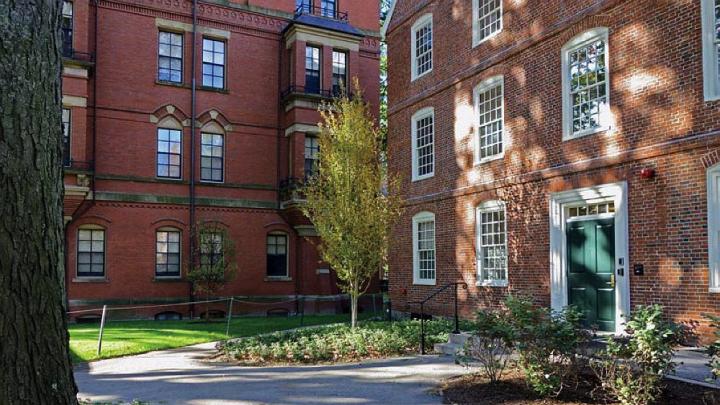Harvard Yard is sacred ground. Admirers expect the canopy of tall trees, trimmed just so (the clean, early-1990s landscape design of Michael Van Valkenburgh); the familiar brick; the contrasting granite of University Hall. Opportunities to change its look are few, but when Nazneen Cooper was invited to seize the most recent one, she had the courage and taste to rethink the landscaping of Massachusetts Hall—a small cluster of leggy rhododendrons, hostas, and low yews, plus a couple of not-very-hardy dogwoods—following its renovation last summer.
During an autumnal walk around Mass Hall, Cooper—who is assistant dean of campus design and planning, involved in most of the Faculty of Arts and Sciences’ projects, with degrees in architecture and landscape architecture (M.L.A. ’95)—said she began with the building itself: a Georgian gem, Harvard’s oldest structure, and today home to both the president and his senior staff and (on the top floor) undergraduates. Given that, and in keeping with Van Valkenburgh’s first principle (he chaired the department when she was a graduate student; see “The Urban Landscaper,” November-December 2013, page 32), Cooper had no hesitancy in subtraction, so Mass Hall, like the other Yard buildings, “can stand proud.” Goodbye to the dogwoods, yews, hostas, and rhododendrons.
The upside is what replaces them. Merely surrounding Mass Hall with lawn would have been costly, given the expense of irrigation lines. And the Yard already has enough expanses of green (or, brown, where tourist or ceremonial throngs have worn the turf down). Cooper and her colleagues (Wayne Carbone, Paul Smith, Jason McKay, Arthur Libby, Ryan Sweeney, and Jack Lemos) instead opted for form, scale, and ground-level colors that will change seasonally.
Alongside the ramp to the front door, low Fothergilla major shrubs (fragrant members of the witch-hazel family) will bloom in spring, detonate fiery fall foliage, then shed their leaves to reveal an interesting winter architecture. Opposite, a Stewartia pseudocamellia—a showy understory tree, with magnificent white flowers—is surrounded by pachysandra, as is the towering locust that anchors the northeastern corner of Mass Hall.
Cooper is both quoting another feature of Harvard Yard, and narrating a story. There is little public art on campus, but two large specimens are the Henry Moore sculpture between Loeb House and Lamont Library, and the monumental Chinese stele by Widener. Drifts of pachysandra, rather than an off-putting barrier, surround both. Hence the use of that ground cover here, a nod to the living sculptural qualities of the locust, with its shaggy trunk, and the prized, mottled-bark stewartia. Near next-door Matthews Hall is a third such sculpture: a paperbark maple (Acer griseum), with an extravagantly cinnamon outer layer and, when mature, socko red (crimson, anyone?) leaves that should light up the brick and stone background. Around the corner on the south side, near the oaks that tower over the courtyard between Matthews and Straus, Cooper has installed an Acer triflorum: yet another textured trunk—plus eye-catching golden-orange fall color. All the new woody stock enlivens the building, but will remain small enough in stature to harmonize.
Inside the tall fence on the Mass. Ave. side, the mature locusts remain but the rhododendrons and ivy are gone. The president’s office will be screened by a row of taller Hamamelis intermedia ‘Arnold Promise’: witch hazels introduced by the Arnold Arboretum in 1928, with yellow blossoms that unfurl in late winter, followed by more good fall color.
To the north, facing Harvard Hall along the main roadway through the Johnston Gate, the allée of tall ash, oak, and tulip trees are now carpeted in fresh sod, allowing the mellow brick and wooden trim of Mass Hall to stand free and clear in the changing light.
Cooper says the purpose of the project (for which Carolee Hill, managing director, real estate, within Harvard’s campus-services organization, was the client in connection with the building renovation) was rethinking the landscaping “to look fresh, to look renewed.” Its restrained results mean that Mass Hall can indeed, like its later siblings, “stand proud.” The new plantings, she said, have “more character and seasonal flavor” than their predecessors, without contradicting Van Valkenburgh’s handsome scheme.
Examining the result, even before things had settled in, Cooper was well pleased. Passersby should be, too, as Harvard’s front door has been subtly rendered more appealing and less imposing. This winter, and in future ones, this is something to enjoy—and to look forward to come spring.








